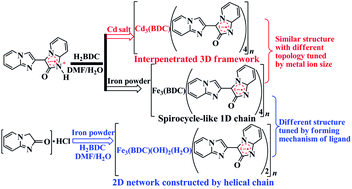The preparation, X-ray crystallography, EPR, and magnetic and luminescent properties of three new metal–anion radical frameworks are described herein. The anion radical ligand (bipo−˙) and co-ligand, 1,4-benzenedicarboxylate (BDC2−), coordinate to Cd(II) centers, leading to an interpenetrated three-dimensional (3D) metal–organic frameworks (MOF), [Cd3(bipo−˙)4(BDC)]n (1). Although [Fe3(bipo−˙)4(BDC)]n (2) and 1 possess the same space group (tetragonal, P42/nbc), and similar rigid spirocycle-like chain and powder X-ray diffraction (PXRD) patterns, 2 exhibits an interesting spirocycle-like one-dimensional (1D) chain network, in which BDC2− behaves not as bridging co-ligand but as a counteranion, according to smaller Fe(II) ion size and long Fe1⋯Fe1′ distance between rigid chains. Thus, metal ion sizes induce different networks of isomorphous 1 and 2. Moreover, the different forming mechanisms of bipo−˙ ligand also result in different structural MOFs: the in situ deprotonation of initial Hbipo−˙ leads to an 1D Fe(II) MOF (2); the in situaldol condensation and then deprotonation of initial hydrochloride salt of imidazo[1,2-a]pyridin-2(3H)-one results in a two-dimensional (2D) Fe(II) MOF, [Fe3(bipo−˙)2(μ2-OH)2(μ2-H2O)(BDC)]n (3). More noteworthy, in 2, BDC2− suffers large distortion, mainly attributed to its strong electrostatic interaction with the Fe(II) cation on the rigid spirocycle chain. Compounds 2 and 3 exhibit broad EPR signals, ascribed to the strong iron–anion radical antiferromagnetic coupling. 1 shows an unusual magnetic phase transition at ∼70 K, and intense fluorescence emission which can even be excited by visible light (460 nm). Both 2 and 3 show strong antiferromagnetic interaction between Fe(II) cation and radical. Compared to 1, two Fe(II) MOFs exhibit obvious blue-shift fluorescence emissions.

